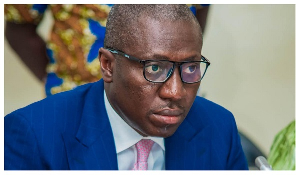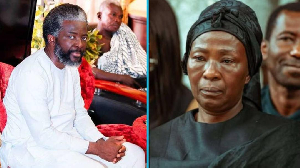Here finally is a ground-breaking value-oriented African story book. These amazing tales will preoccupy both children and adult minds.
The stories are simple and direct in speaking and drawing out the African world. They provide deep insights into African concepts and structures of the society, the communal and individual responsibilities together with the integrated value-system.
In this extraordinary narrative of diverse tales, the power of the writer lies in her firm immersion in Africa.
One finds a breathtaking view of African philosophies, world view and way of living, which can only emanate from a narrator who has Africa uncompromisingly born in her.
Most incredible tales
Right from the first page, the author, Naana Opoku-Agyemang, masterfully and with engaging clarity tells the most incredible tales with a fidelity to Africa’s soul. Discernibly, these didactic tales have been generated from a wellspring of African consciousness.
There is a sensation that these stories take the reader to the roots of Africa. One is overwhelmed by a feeling that for thousands of years these tales have been told and retold, shaped and reshaped, fitted and refitted to carry the vitality of Africa through time for those who have had ears to hear.
Just as an authentic Griot, the author remoulds them to meet the audience’s changing essentials and social demands.
The African, as a moral and eco-centric being at one with nature, has been created anew. Among other things, these multi-purpose tales hold a mirror for Africans to see who we were and compare it with who we are.
These stories and their inherent values and world view give the African another lease of life in a rapidly changing world in which Africa is being devoured by the vultures of imperial cultures. Each story illustrates a cultural truth.
The end of each story elicits the question: “What wisdom have I gained?” Africa is converted into a place of thought. Africa stands as a value system.
Reading these vivid and captivating stories makes it heartrending to see African children absorbing through rhymes such “Humpty Dumpty” and Western folklore, myths and tales - the brick work, world view and values of Western culture as if they were cultural universals.
Africa’s vulnerability is exposed through the fact that even in the 21st century, from the first day of reading or classroom learning, the experience of the African child is whooshed out of Africa.
Juxtaposing Naana Opoku Agyemang’s work with the contents of the current school learning, it is obvious that the consciousness matrix of the indigenous African world has yet to be salvaged.
From the English world, as “Pussy cat, Pussy cat” illustrates, the African child is transmuted into a cat pussyfooting to London just to have a glimpse of an imperial majesty whose culture bears the responsibility for the colonising of the African space, time, and thought.
The primary seeds are then implanted for the African child to sprout into an enemy of his own indigenous world with a great admiration for the culture of his mis-education.
Thus, the reading experience makes this African child’s existence exotic and toxic to the indigenous cultural reality and cultural self-understandings.
These incredible tales make you see how the African way of life becomes Humpty Dumpty being smashed by the (feudal and class-ridden) culture of the king’s horses and men.
Besides the joys of reading and expanding the knowledge of other cultures, such pussycat stories serve as ‘cultural irrelevancies.’
Written in very simple and plain language, Naana Opoku-Agyemang painstakingly weaves the tales out of the cultural fabric woven by the ancestors with gritty authenticity.
Each compelling story reveals a magnificent artistry which blends the various hues of the society onto an inviting tapestry reflecting a sacred unity of the human being, the flora and the fauna. This tapestry is ingrained with the ideals of collective and communal responsibility. Each strand of the garment of each tale seems to be in place through the diction, the characters and the setting.
Author’s style
The author’s style of putting her person in the narration unwittingly captivates the sentiments of the reader.
With psychic integrity, the personalised tales integrate the reader into the soul of each story. Intriguingly, this uniqueness in style strongly appeals to the intellect. Each part seems as fresh and inviting to be read over and over again. This is a marvellous achievement.
As the exciting characters in the form of lions, fowls, wolves, flies, tigers, deer, elephants, as well as the ubiquitous tortoise and spider strut through the pages, dishing out their wisdom teachings, it dawns on the meditative adult reader that this work falls into the genre of literature, which intends to salvage, reclaim, maintain and perpetuate the beauty of African culture.
Unquestionably, only an educator who understands the psychology of education can write such an educative piece of work. It is invaluable for the African world.
Colourful illustration
To make it easy for children to read and perhaps to catch the fancy of adults, these remarkable tales are beautiful and colourfully illustrated.
The illustrations add a special spice of humour to the pages. Each illustration is worthy of study as they season the stories. However, the illustrations inadvertently draw attention to the advantages of African story telling.
Although one can imagine these stories being narrated to children listening with enrapt attention under the moonlight, the songs and the call and response which pervade African storytelling become very conspicuous by their absence.
This highlights the limitations of writing. On the other hand, it serves as an invitation to teachers and parents to enter the imagination of the writer and infuse the stories with songs to flavour the stories.
On the last page, a reader is bound to ask: “Which is the most incredible story?” My answer is certainly: “All!” Africa is being resurrected.
The book is a resounding success. Each tale shall be consulted in the quest for the living wisdom of Africa. As a matter of fact, this book should be a required reading for all people who are rooted in Africa. It is my fervent prayer that it will be read and reread by all educational institutions.
It is highly recommended for study by African-centred political scientists, theologians, sociologists and lovers of the African way of life.
Opinions of Monday, 12 October 2015
Columnist: Daily Guide















